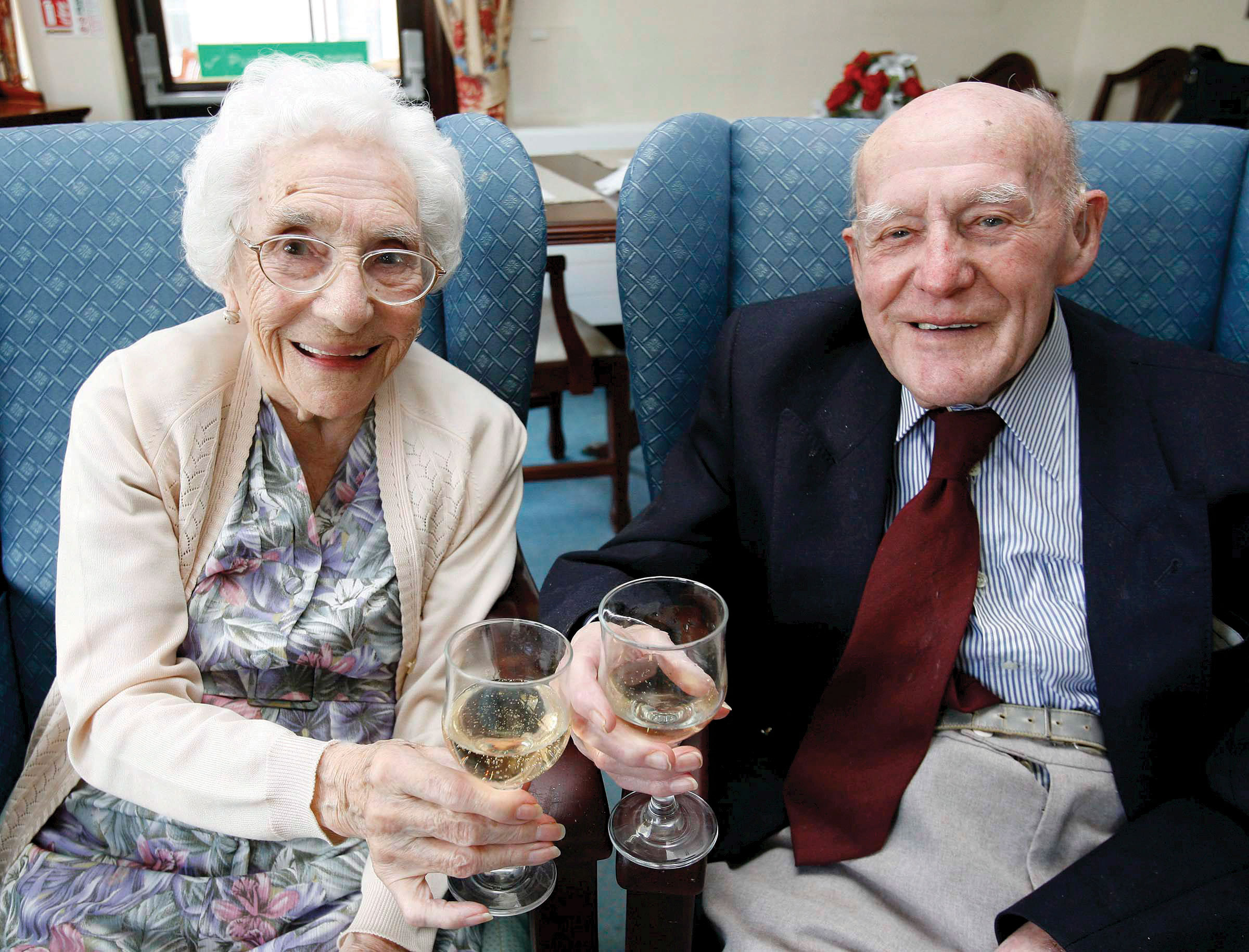This is “Liking and Loving”, chapter 8 from the book Social Psychology Principles (v. 1.0). For details on it (including licensing), click here.
For more information on the source of this book, or why it is available for free, please see the project's home page. You can browse or download additional books there. To download a .zip file containing this book to use offline, simply click here.
Chapter 8 Liking and Loving
Britain’s Longest Married Couple Celebrate a Quiet 80th Anniversary

This chapter will discuss the characteristics of good close relationships—those that allow couples, such as Frank and Anita Milford, to remain happy and healthy together.
© SWNS.
Frank and Anita Milford are in some ways your average couple: They met in 1926 at a YMCA dance, married in 1928, had two children, and lived together in the same a three-bedroom house their entire lives. But unlike many other couples, Frank and Anita’s marriage lasted—in fact, it really lasted. In May of 2008, the pair equaled the record for being Britain’s longest married couple—80 years of marriage.
To celebrate their 80th wedding anniversary, Frank (100 years old), and Anita (99 years old) spent a quiet weekend together—pretty typical of most of their days.
“At our age that’s all you need,” said Mr. Milford. “Just us together, no big fuss.”
Frank and Anita indicated that one of the secrets to a successful marriage was to “share a little kiss and cuddle every night before bed. It’s our golden rule.”
The Milfords believe that making time for one another is vital to keeping the relationship healthy. They claimed that respect and a process of “give and take” are great ways to sustain a relationship.
“We do everything together even after nearly 80 years.”
Like most couples who have been together for a number of years, there are still some cross words and everyday squabbles. Regardless, their relationship remains one that is loving and healthy.
Source: Miller, V. (2008, 24 May). Britain's longest married couple celebrate a quiet 80th anniversary. The Telegraph. Retrieved from http://www.telegraph.co.uk/news/uknews/2020233/Britains-longest-married-couple-celebrate-a-quiet-80th-anniversary.html.
In prior chapters, we have considered the basic processes of person perception. In doing so, we have focused primarily on our perceptions of people we do not know very well and with whom we do not have many social connections. But people also desire and need to develop close relationships with others, particularly those others who help us engage in reproduction and child rearing and who provide social supportThe comfort that we receive from the people around us—for instance, our family, friends, classmates, and coworkers.—the approval, assistance, advice, and comfort that we receive from those with whom we have developed stable positive relationships (Taylor, 2007).Taylor, S. E. (2007). Social support. In H. S. Friedman & R. C. Silver (Eds.), Foundations of health psychology (pp. 145–171). New York, NY: Oxford University Press.
Close relationshipsRelationships between people that are characterized by loving, caring, commitment, and intimacy. are relationships between people that are characterized by loving, caring, commitment, and intimacy—such as those between adult friends, dating partners, lovers, and married couples (Clark & LeMay, 2010; Hendrick & Hendrick, 2000).Clark, M. S., & Lemay, E. P., Jr. (2010). Close relationships. In S. T. Fiske, D. T. Gilbert, & G. Lindzey (Eds.), Handbook of social psychology (5th ed., Vol. 2, pp. 898–940). Hoboken, NJ: John Wiley & Sons; Hendrick, C., & Hendrick, S. S. (Eds.). (2000). Close relationships: A sourcebook. Thousand Oaks, CA: Sage. These relationships are determined by biological, evolutionary, individual, and cultural factors. Successful close relationships involve the positive influence of cognitive variables, including perceptions of similarity with the other, interdependence, commitment, and the incorporation of other into the self-concept, as well as affective variables, including attachment, intimacy, and commitment. Our close relationships help us meet the goals of self-concern and other-concern.
In this chapter, we will consider the benefits that come from our close relationships, the principles that lead people to become attracted to others, and the variables that help create stable, healthy, and happy close relationships. In addition to being vitally important to us in an evolutionary sense (effective child rearing requires committed and effective parents), close relationships bring us health and happiness when we are able to create successful ones; they may produce a profound sense of loneliness and sadness when we are not.

Close relationships form the basis of human reproduction, child rearing, and life satisfaction.
© Thinkstock
People are well aware of the importance of having other people in their lives. When they are asked what makes them happy, people of all ages indicate that having friendships and good relationships with others is what they care about the most (Baumeister & Leary, 1995).Baumeister, R., & Leary, M. (1995). The need to belong: Desire for interpersonal attachments as a fundamental human motivation. Psychological Bulletin, 117, 497–529. And our self-esteem is in large part determined by how much we feel that we are accepted by others (Leary, 2005).Leary, M. R. (2005). Sociometer theory and the pursuit of relational value: Getting to the root of self-esteem. European Review of Social Psychology, 16, 75–111. Self-esteem rises when we feel accepted and valued by others and falls when we do not (Leary & Cox, 2008).Leary, M. R., & Cox, C. B. (Eds.). (2008). Belongingness motivation: A mainspring of social action. New York, NY: Guilford Press. People who do not feel that they are able to develop the types and quality of social relationships that they would prefer to have are lonely—a highly unpleasant and potentially unhealthy state (Cacioppo & Patrick, 2008).Cacioppo, J. T., & Patrick, W. (2008). Loneliness: Human nature and the need for social connection. New York, NY: W. W. Norton.
Close relationships also keep us healthy. People who do not have adequate social support in the form of friends and family have more physical and mental health problems than do those with adequate social relationships (Cacioppo, Hawkley, & Bernston, 2003; Cacioppo et al., 2002).Cacioppo, J. T., Hawkley, L. C., & Bernston, G. G. (2003). The anatomy of loneliness. Current Directions in Psychological Science, 12(3), 71–74; Cacioppo, J. T., Hawkley, L. C., Crawford, E., Ernst, J. M., Burleson, M. H., Kowalewski, R. B,…Berntson, G. G. (2002). Loneliness and health: Potential mechanisms. Psychosomatic Medicine, 64(3), 407–417.
In summary, our close relationships make us happy and healthy, and the lack of them leaves us lonely and hurting. We experience higher self-efficacy, self-esteem, and positive mood when we believe that our friends and partners are responding to us supportively and with a concern for our needs and our own welfare. Our relationships with others help us buffer the negative effects of stress, avoid unhealthy behaviors, and cope with serious physical illness. And our close relationships allow us to express our fundamental desires to reach out and respond to other people.




